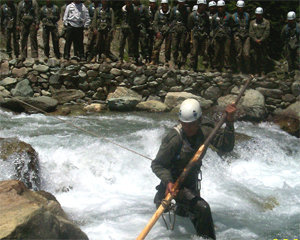| Introduction |
1.Mountaineering conducted in mountainous terrain may often require crossing of swift flowing rivers or streams. Such crossings should not be taken lightly. The force of the flowing water is generally great and is most often underestimated. When rivers or streams must be crossed, there are a variety of techniques a mountain leader may choose from, depending upon the type of stream, its width, speed of the current, and the depth of the water. Some of the most commonly used techniques of stream crossing are mentioned in the succeeding paragraphs. |
Reconnaissance |
2. Maps, photos and aerial reconnaissance may not always reveal the enormity of a water obstacle or its likely crossing sites. Site selection is therefore; extremely important once crossing has been decided. This site selection must be made before the arrival of the main body. A distant view, perhaps from a ridge, is sometimes better than a hundred close views from a river bank. The following must be kept in mind before deciding the site of crossing :– |
| |
(a) A dry crossing on a fallen timer or logs is preferable to attempting a wet crossing. |
| |
(b) A crossing point should normally be chosen at the widest, and thus shallowest, point of the river or stream, for wading. |
| |
(c) Sharp bends in the river should be avoided since the water is
likely to be deep and have a strong current on the outside of the bend. |
| |
(d) The crossing site should have low enough banks on the near and far side to allow a man carrying equipment to enter and exit the stream with relative ease. |
Preparation of Mountaineers and Equipment |
3. Men and equipment should be prepared for a crossing in advance as far as possible. Final preparation can be done close to the water obstacle, just before the crossing takes place. This preparation incl the following :–
|
| |
(a) Waterproof water-sensitive items. Wrap radios, binoculars, papers, maps and any extra clothing in waterproof bags. These bags also provide additional buoyancy in case of a fall. |
| |
(b) Trousers are unbloused and shirts are pulled out of the trousers. All pockets are buttoned. This allows water to escape through the clothing. Otherwise the clothing would fill up and retain water, which would weigh the body down. |
| |
(c ) Individual equipment should be attached to the pack or slung over the shoulder. |
| Methods of Stream Crossing |
| 4. Not all mountain rivers or streams are fordable. In such a case an alternate route should be used or a crossing be made with the help of the expert mountain climbers. Some of the techniques which can be used to cross rivers or streams that have a depth generally not exceeding waist deep are as under
|
(a) Wading. Whenever possible, and when the degree of experience permits, streams should be forded individually for a speedier crossing. Some useful tips are as follow:– |
(i) The individual should generally face upstream and slightly sideways, leaning slightly into the current to help maintain balance. |
|
(ii) The feet should be shuffled along the bottom rather than lifted, with the downstream foot normally in the lead. |
(iii) Short, deliberate steps should be taken.
|
(iv) Individual crossing the stream may be secured with the help of a rope, especially non swimmers and weak swimmers. |
| (v) If possible, place a rope across the stream duly secured at both ends. The rope should be just above the water. |
| (vi) Post look out man above the crossing sites for giving advance warning( flash floods etc). |
| (vi) Look out man may also be located downstream for help, when required. |










